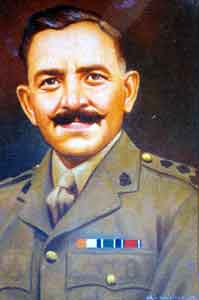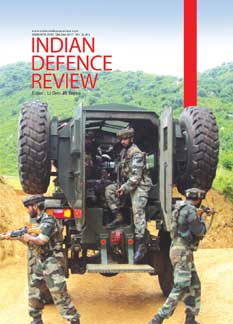
Brig Rajinder Singh - the man who saved the Kashmir Valley from falling into the hands of Pakistani Raiders
On October 24, India got the first news of invasion of Kashmir. It was through a formal dispatch from Pakistan Army Headquarter informing the supreme commander of all British forces in India and Pakistan, Field Marshal Sir Claude John Eyre Auchinleck. He was informed that, “Tribesmen estimated 5,000 Afridis, Wazirs, Mahsuds, Swatis had attacked Muzaffarabad and Domel capturing both on October 22, tribesmen reported approaching Srinagar. Kohala in danger of being attacked. Tribesmen in large numbers expected to go to Kashmir.”
On that same day at 11pm, Maharaja sent an S.O.S to the Indian government asking for Indian troops to rescue Kashmir. This request was considered the next day on October 25, in Defence Committee of the cabinet.
Apart from the legalities, since the state of Kashmir had still not acceded, there were enormous military challenges in setting foot for saving Kashmir. Obviously there existed no plans for sending Indian troops to Kashmir. Srinagar was 480 km from nearest border across the Pir Panjal with no motorable road link from the Indian side. Troops in East Punjab were busy rescuing the refugees and maintaining law and order. Only way, left was to air transport the troops by air to Srinagar.
Landing fully laden transport planes, with combat ready troops along with the logistics at hard scale, was by no means a lesser task in itself. This was more so because the landing ground was located over 1524 meters, it was poorly maintained, and fell far short of international standards of the times.
For the troops, the unforeseen risks were far too many, finding themselves stranded in a distant valley with no depots, ancillary services or regular lines of communications could just prove suicidal. Totally, dependent on an uncertain air transport for all the requirements facing the enemy with literally no information made this complete proposition highly risky.
With signing of instrument of Accession by the Maharaja on October 26, and later by evening, the acceptance of this legal document by the Governor-General of India, Kashmir became legally, morally and constitutionally part of Indian Dominion.
Now, it became an urgent requirement to throw back the raiders from Kashmir. This meant that regular Indian troops must be sent there with utmost speed. Brig Kalawant Singh, the acting CGS, took urgent steps to find and prepare troops to be sent to Srinagar. The choice fell on 1 Sikh, commanded by Lt Col Diwan Ranjit Rai.
He was tasked by the CGS to fly to Srinagar early on the morning of October 27, secure the aerodrome and civil wireless station the earliest. Thereafter, if possible, he was to drive away the enemy from the neighbourhood of Srinagar and aid the local government in maintaining law and order.
So uncertain was the situation in the Valley that Lt Col Rai was instructed to circle the Srinagar air field and carefully scan the country side just in case the raiders had occupied it. If so, he was to fly back and land with his men at Jammu. Such a rider to an ‘Operational Instruction’ must surely be unique in modern military history. This clearly was an indication of the immense uncertainty and hazards that lay ahead of these Indian troops.
Lt Col Rai and his battalion group were allocated four flights. Flight A comprised of 6 Dakota transporters and Flight B of 3 Dakotas. They took off from Palam and Safdarjung airfield respectively at 5:00 am. Flight C & D comprised of 8 and 11 Dakota aircrafts left Palam at 11:00 am and 1:00 pm respectively. The first flights, A&B airlifted Tactical Headquarters of 1 Sikh, one rifle company and one composite company of RIA.
Each Dakota carried 15 combat ready soldiers plus 250 kgs of emergent supplies. Each flight was to be tactically and administratively self-contained, so that if necessary the troops could go into action immediately on landing.
After an uneventful flight, the Dakota carrying Lt Col Rai touched down at Srinagar airfield at 8:30 am on October 27, 1947. Other planes of the first flight made a bee line and all landed by 10:00 am. The Army Headquarter was informed that the first party was at last at Srinagar. Operation Rescue had just begun.
The situation was critical in the extreme. Two state forces’ platoons were to prevent the raiders advance. They were holding their defensive position dug on a high ground 5 km east of Baramula. Pakistani tribal raiders had entered Baramula on the eve of Oct 26 and, they could have easily commenced their advance the next morning. By any military sense, the defended position of state troops was just a minor opposition for such a large strength of raiders present. Once overrun, the road to Srinagar would lay open and completely undefended.
Had it not been the lure for raping and looting at Baramula, Srinagar was to be with the raiders flying the Pakistani flag by afternoon of October 27, 1947. And Lt Col Rai would have been left with no option, other than, to fly out to Jammu immediately after touching down. As a contingency the rider to ‘Operation Instructions’ had initially stipulated this.
As the Pathans entered Baramula, it was promptly given to plunder and rapine. October 27, kept the raiders busy with their savage excitement for looting and raping. Hindus and Sikhs were hunted down and killed; their houses looted and burnt. Young women were forcibly abducted to be carried off and sold like cattle in the streets of Rawalpindi and Peshawar.
A Muslim patriot, Maqbool Sherwani was shot dead in public square as he had called Hindus and Sikhs as his brothers. An Englishman, Col Dykes along with several of his assistants at a missionary hospital were shot dead and hospital burnt. The nuns at the mission were raped and killed. On this fateful day the ultimate goal of ‘Holy War’ or ‘Jihad’ was totally lost.
Having two platoons guarding the axis, only state forces reserve available was at Srinagar; a squadron of horsed cavalry. The situation got precarious by the minute, Lt Col Rai decided to send forward his sole company of troops immediately to reinforce these two platoons of the state forces. These handful troops of 1 Sikh completed this task by mid noon at twelve. About the same time the Commanding Officer signaled to Delhi, “…….500 enemy and 2000 locals at Baramula cannot be held by state forces…. reinforcing state troops to prevent break through…..buildup to be expedited.”
There was hope in some delay in advance as tribal raiders were busy looting Baramula. But unless 1 Sikh was made up to full strength by afternoon October 28, Lt Col Rai was not confident of saving Srinagar.
In reply to Lt Col Rai’s messages, AHQ informed him at 11:00 pm the same day, that on October 28, air force will carry out strafing. And on October 29-30, Brigade Tactical Headquarter and one extra battalion will be flown in followed by another battalion by air if possible or else by road.
On October 27, East Punjab Command was ordered to establish proper line of communication from Pathankot to Jammu as soon as possible.
Gallant troops of 1 Sikh, the ‘Defenders of Srinagar’ passed the night of 27/28 October in vigilance in their hastily dug positions east of Baramula. But no attack developed that night. Next morning, that is October 28, Lt Col Rai himself went with two more companies of 1 Sikh to the frontline trenches. He even contemplated attacking Baramula and throwing out the raider in short order. However, Lt Col Rai learnt that the enemy had started building up for an attack to break through for Srinagar. A bitter fighting soon erupted. The attacker was held up for a few more hours, before he realized that the defensive position of the Sikhs was indeed small, and it can easily be outflanked and bypassed.
When the enemy began to encircle his position, Lt Col Rai went back and selected another position some 8 km nearer to Srinagar.After this reconnaissance, he returned to his men and ordered them to occupy new position. To the orders of their commanding officer, his men quietly and skillfully fell back to occupy the new positions.
While seeing off the last of his rear guard, Lt Col DR Rai was hit in head by a stray bullet, the death was instantaneous. Thus, fell a gallant son of India, in defence of freedom and honour; he had arrived just 24 hours ago.
In the valley, the situation remained critical throughout the day on October 28, One VCO, five Sikh soldiers had been killed and fifteen wounded along with Lt Col Rai that morning.
The enemy was freely using artillery and mortars by now. They were forced to make believe of a far superior strength of Indian troops by skillful use of ground and tactical acumen of Commanding officer of 1 Sikh. The enemy in doubt refrained itself of pressing on, any major attack. This got the Indian army, those crucial hours to speedy build up. During the day balance of 1 Sikh troops and 218 troops of 1 Kumaon were flown in. October 29, was touch and go for the slender forces defending Srinagar.
Not only October 27, but all the days that followed thereafter were INFANTRY DAYS.





